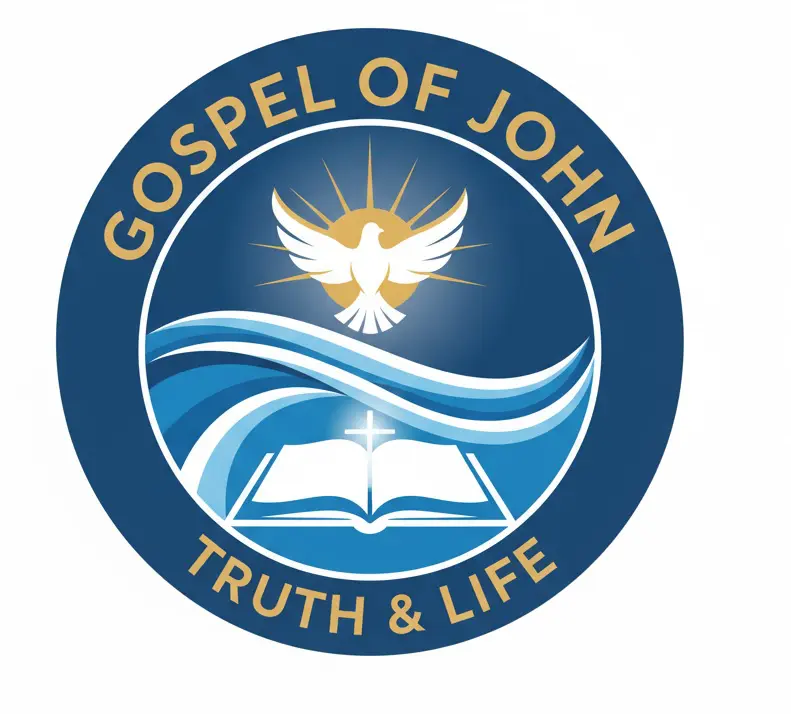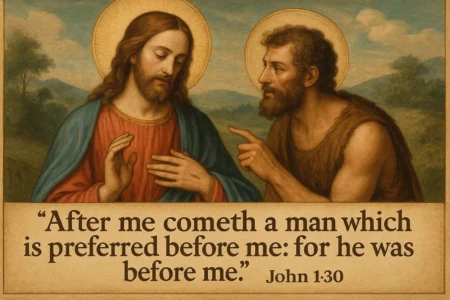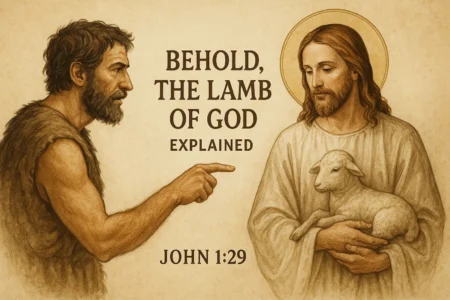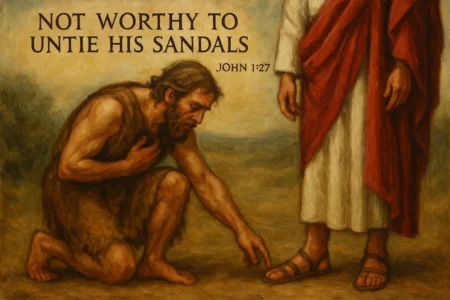You have to picture the scene. The air in the Judean desert wasn’t just hot; it was electric. A strange, rugged man named John was pulling huge crowds out of Jerusalem, and the religious leaders were getting nervous. Really nervous.
This guy was preaching a blistering message about repentance. Then he was plunging people into the Jordan River. His actions were radical. They were symbolic. And they were a direct challenge to the establishment.
Finally, the authorities sent a delegation to corner him. They got right to the point: “Who are you?”
John dodged. He said he wasn’t the Christ. He wasn’t Elijah. He wasn’t “the Prophet.” So they pressed him, frustrated: “Why in the world are you baptizing, then?”
His answer, which we read in John 1:26, is one of the most profound and humble statements in the Bible: “I baptize with water, but among you stands one you do not know.”
That single sentence cuts right through all the political and religious tension. It draws a line in the sand. It perfectly defines John’s mission by pointing away from himself to the one who was coming. To really get the John 1:26 meaning, we have to understand this wild man, his shocking message, and the historical earthquake happening right under the delegation’s nose.
More in John Chapter 1 Category
Key Takeaways
- John’s Dunking Was Just the Warm-Up: John’s water baptism was a symbol. It was an outward sign that people were truly sorry for their sins and were getting ready for the Messiah.
- This Wasn’t Salvation (Not Even Close): John himself is crystal clear that his water ritual was limited. It was a human act of preparation, not the divine act of salvation.
- It’s All About the Contrast: The whole meaning hinges on the gap between “I baptize with water” and the one who was coming to “baptize with the Holy Spirit and fire.”
- The Messiah Was Hiding in Plain Sight: That phrase “among you stands one you do not know” was a direct shot at the leaders. Jesus was right there, but their spiritual blindness was so complete they couldn’t see him.
- John’s Job Was Humility: John’s whole purpose was to get smaller so Jesus could get bigger. His answer is a masterclass in humility, pointing everyone and everything away from himself and toward Christ.
Who Exactly Was This Man Named John?
We hear “John the Baptist” and think of a peaceful, robed figure in a stained-glass window.
Forget that picture.
The real man was anything but polished. He was a force of nature. A wild man who lived in the desert. He wore clothes made of camel’s hair. He ate locusts and wild honey. This wasn’t some eccentric phase; it was a deliberate signal. He was intentionally echoing the prophet Elijah. He was showing Israel that he was an old-school prophet—uncompromising, untamed, and completely unafraid of the establishment.
He was the “voice of one crying in the wilderness,” just as Isaiah had prophesied. His job wasn’t to build a brand or start a new denomination. His entire purpose was to be the forerunner. The advance scout. The guy who prepared the way for the main event. He was the gravelly-voiced alarm clock for a sleeping nation. His message was blunt: “Repent, for the kingdom of heaven is at hand!”
I remember when I left a stable corporate job to follow a different path. For a while, I felt like I was in my own “wilderness.” Everything familiar was gone. The future was a total unknown. That small experience gives me just a tiny sliver of insight into John. He chose the wilderness. He stripped away every comfort, every credential, every safety net. Why? To have one thing: a pure, unfiltered message from God. He wasn’t a temple priest. He wasn’t a certified scholar. He was an outsider. And that’s exactly what gave his message its power.
Why Was He Even Baptizing in the First Place?
This is where the religious leaders got really concerned. Baptism wasn’t a totally new idea, but the way John used it was.
The Jews already practiced ritual washings. They were called mikvah. These were baths for ceremonial purity. For example, a Gentile who wanted to convert to Judaism would immerse in a mikvah. It was a standard practice. You can learn more about this ancient ritual and its significance from resources at Dallas Theological Seminary, which notes these immersions were about ritual purification.
But John’s baptism was different. Radically different.
He wasn’t baptizing Gentiles into Judaism. He was baptizing Jews. He was telling them that being a “child of Abraham” wasn’t enough to save them. This was an outrageous, offensive claim to the religious elite. He was essentially telling the “insiders” that they were spiritually “outsiders” and needed to repent and be cleansed just like everyone else.
His baptism was a public, physical symbol of an internal decision. It was a funeral for the old life. By going down into that river, a person was publicly declaring, “I’m done with my old way of living. I am turning from my sin, and I am getting ready for the King.” It was a powerful, tangible act of surrender. The water itself wasn’t magic. It didn’t save them. It was simply the line they crossed to show they were dead serious about repenting.
Why Were the Priests and Levites So Worried?
When this delegation of priests and Levites—sent by the Pharisees—showed up, it wasn’t a friendly theological chat. It was an interrogation. These were the religious gatekeepers, the guardians of orthodoxy, and John was operating way outside their jurisdiction. He had no official sanction from the Sanhedrin, the Jewish high council. He was a rogue agent, and he was attracting thousands.
You have to understand the tension of the time. Judea was under Roman occupation. The Jewish leaders were walking a tightrope, trying to maintain their religious authority without provoking Rome. Any man who drew a massive crowd, especially one talking about a “kingdom,” was a potential revolutionary. He was a spark near a powder keg.
So their questions—”Are you the Christ? Are you Elijah? Are you the Prophet?”—were a checklist of messianic figures they were expecting. They were trying to put John in a box. Is he the all-powerful Messiah? Is he the returning prophet Elijah? Is he the “Prophet” that Moses promised in Deuteronomy? When John said “no” to all three, they were completely baffled. If he wasn’t any of these, what gave him the right to act with such authority? “Why then do you baptize?” was their way of saying, “Who do you think you are?”
What Does “I Baptize with Water” Really Mean?
This brings us to the core of the John 1:26 meaning. John’s answer is brilliant. He doesn’t defend his own authority. He doesn’t give them a new credential. He simply defines his mission by its limitation.
“I baptize with water…”
This phrase is loaded with humility. He’s effectively saying, “What I do is merely symbolic. It’s external. It’s preparatory. I am dealing with the outside. I am using the most common element on earth: water.” He’s drawing a hard line between his work and the work of the one he’s announcing.
I once made a decision to quit a destructive habit, and I told a few close friends. That verbal declaration was my “water baptism,” in a sense. It was the outward sign. It didn’t do the work of breaking the habit, but it committed me to the process. It was the easy part. The real, internal work was much harder and came later.
John is telling these leaders, “You’re all worked up about this water. You’re focused on the symbol. My baptism is just the signpost, not the destination. It’s the finger pointing at the moon, not the moon itself. It’s the opening act, and you’re treating it like the main event.” This was a profound rebuke to their spiritual priorities. They were so busy policing the rituals that they were missing the reality.
Who Is the “One You Do Not Know”?
The second half of the verse is the payload: “…but among you stands one you do not know.”
This is the thunderclap.
While they were grilling John, the Messiah was already there. He was standing right there “among them,” breathing the same air, walking on the same dust. He was in their midst, and they were completely blind to him. This is the ultimate tragedy. The experts in the law, the men who supposedly studied the prophecies their whole lives, were staring right at the fulfillment of those prophecies and saw nothing.
Why didn’t they know him? Because they were looking for the wrong thing.
- They wanted a political king who would drive out the Romans.
- They wanted a military conqueror who would restore Israel’s earthly glory.
- They wanted a powerful figure who would affirm their religious system.
They did not want a humble carpenter’s son from a backwater town in Galilee. They did not want someone who would talk about loving their enemies, forgiving sins, and the “kingdom of God” being within them. Jesus didn’t fit their mold, so they missed him. John’s statement was a charge of spiritual blindness. “You’re here interrogating me,” he implies, “while the very Son of God is standing behind you, and you don’t have a clue.”
What’s the Difference Between John’s Baptism and Jesus’s?
John 1:26 only gives us his side of the equation: “I baptize with water.” To get the full picture, we have to look at what John says in the other Gospels. In Matthew 3:11, he makes the contrast explicit:
“I baptize you with water for repentance. But after me comes one who is more powerful than I, whose sandals I am not worthy to carry. He will baptize you with the Holy Spirit and fire.“
This is the entire point. John’s baptism and Jesus’s baptism are worlds apart. It’s the difference between a picture of a fire and the fire itself.
- John’s Baptism (Water):
- Element: Water
- Source: Man (John)
- Purpose: Repentance (a human turning from sin)
- Result: An outward symbol of an inward decision
- Jesus’s Baptism (Spirit & Fire):
- Element: The Holy Spirit and Fire
- Source: God (Jesus Christ)
- Purpose: Regeneration (a divine new birth)
- Result: An inward transformation, empowerment, purification, and salvation
John’s baptism was about what we do. Jesus’s baptism is about what He does. John’s baptism could get you wet, but Jesus’s baptism could change your nature. John’s was a human work pointing to a divine work. Jesus’s was the divine work itself. This is the central contrast that gives the John 1:26 meaning its full power.
What Did John Mean by “Whose Sandal Strap I Am Not Worthy to Untie”?
John follows up his statement by defining his relationship to this “one” he speaks of. In John 1:27, he says, “…he who comes after me, the strap of whose sandal I am not worthy to untie.”
This isn’t just poetic humility. It was a shocking cultural statement. In that time, untying someone’s sandals was the job of the lowest, most menial slave. A disciple was expected to serve his rabbi in many ways, but rabbinic law explicitly forbade a rabbi from requiring his Jewish disciple to perform this task. It was considered too demeaning.
So, what is John saying? He’s saying that his relationship to Jesus isn’t even that of a disciple to a rabbi. He is saying he is lower than the lowest slave. He is placing an infinite distance between himself and the Christ.
Think about that. John was arguably the greatest prophet who had ever lived. Jesus himself said, “Among those born of women there has arisen no one greater than John the Baptist” (Matthew 11:11). And this man, the greatest of all prophets, looks at Jesus and says, “I am not even worthy to be the slave who washes his feet.”
This staggering humility is what made John’s message so trustworthy. He had zero personal ambition. He wasn’t trying to build his own brand. He was the ultimate anti-celebrity. His entire life had one goal: to point to Jesus. And when Jesus finally appeared, John was more than happy to fade into the background. His famous statement, “He must increase, but I must decrease” (John 3:30), is the summary of his life and the key to his greatness.
Are We Still Guilty of Not “Knowing” Him Today?
John’s words, “among you stands one you do not know,” echo powerfully across the centuries. It’s tempting to read this and judge the Pharisees for their blindness. How could they miss him?
But the challenge is for us. How often does Jesus stand “among us” while we remain completely unaware?
We might be looking for him in the thunderous miracle, the dramatic emotional experience, or the perfectly-run church program. But maybe he is standing among us in the face of the poor, the inconvenient neighbor, the difficult family member, or the quiet whisper of conscience. Maybe we are so busy with our own religious checklists, just like the Pharisees, that we fail to see the living Christ right in front of us.
We look for a “God” who will fix all our problems, give us prosperity, and affirm all our choices. We don’t always want the Christ who calls us to take up our cross, love our enemies, and die to ourselves. Like the first-century leaders, we have a “Messiah” mold, and when Jesus doesn’t fit it, we don’t recognize him. The John 1:26 meaning serves as a permanent warning: don’t get so focused on the rituals of faith that you miss the person of Christ.
What Is the Final Takeaway from John 1:26?
The meaning of John 1:26 is a beautiful summary of the gospel’s “before” and “after.” John represents the “before.” He is the climax of the Old Testament, the culmination of all the law and the prophets. His baptism with water was the final, urgent call to “get ready.” It was the best that humanity had to offer: repentance, symbolic cleansing, and a humble heart.
But it was not enough.
It could prepare the way, but it couldn’t be the way. John’s message was, “I’ve taken you as far as I can. My water can wash the dust off your skin, but it can’t wash the sin from your heart.” He was, by his own admission, the opening act. And he was now pointing to the headliner, the one who wouldn’t just use water, but who would baptize with the very presence and power of God—the Holy Spirit.
John’s water baptism was a declaration of spiritual bankruptcy. It was an admission that we need a savior. And in John 1:26, the forerunner, with all the humility in the world, steps aside and points to the one standing in the crowd. “Stop looking at me,” he says. “He’s here.”
FAQ – John 1:26 Meaning
Why did John the Baptist emphasize his humility when describing his relationship to Jesus?
John emphasized his humility by stating he was unworthy to untie Jesus’s sandal strap to demonstrate his lowly position compared to Christ, highlighting that his role was to prepare the way for Jesus, not to seek personal glory or recognition.
How does John’s description of his baptism differ from the baptism Jesus offers?
John’s baptism was a symbolic act of repentance involving water, performed by a human, signifying outward commitment to change. Jesus’s baptism involves the Holy Spirit and fire, representing divine regeneration, inward transformation, empowerment, and salvation directly from God.
What does John mean when he says he is not worthy to untie Jesus’s sandal strap?
This expression illustrates John’s profound humility, indicating he sees himself as lower than the lowest servant. It underscores his recognition of Jesus’s divine greatness and his own subordinate role in relation to Christ.
Are we guilty of not truly recognizing Jesus today like the people in John’s time?
Yes, just as the religious leaders in John’s time often failed to recognize Jesus due to their expectations and priorities, we can also overlook Christ when he appears in unexpected places or in forms that do not match our preconceived notions, emphasizing the importance of spiritual awareness and humility.





